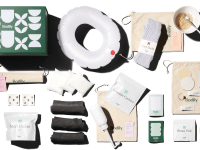This simple product helped my diastasis recti
The Post-Natal FITsplint is surprisingly effective
 Credit:
ReCore Fitness
Credit:
ReCore Fitness
Products are chosen independently by our editors. Purchases made through our links may earn us a commission.
Having a baby is tough. But what’s not talked about nearly enough is the plethora of hurdles a postpartum parent faces in their physical recovery.
“Bounce back” culture leads people to believe that major organs, muscles, and body shape will just return to pre-pregnancy status within a few months. But for 60% of postpartum parents with a diagnosis of diastasis recti abdominus (DRA)—a separation of the abdominal muscles during the stressors of pregnancy—it’s not that simple.
When I first heard about the Post-Natal FIT-splint from my pelvic-floor PT, you can imagine that, as a mom of four boys in seven years, I was dubious about it being able to get rid of my mom-pooch. But, I had to try it, since I had been diagnosed with a solid case of DRA after visiting a postpartum pelvic floor therapist, Julie Brehm, MPT, BCB-PMD, CLD. She told me that even closer to 80% of pregnancies can result in DRA, and that the uterus expanding to 1,000 times its normal size is to blame, along with the pregnancy hormone Relaxin.
What is the Post-Natal FITsplint?
Made from flexible material, the FITsplint has two different belts, one above the other, which pull in opposite directions, effectively cinching the belly muscles back together. The belt is different from pregnancy belts, which focus on support while the baby grows, or postpartum belts, which offer compression.
Ideally, it's best to begin wearing the FITsplint within 3 to 6 weeks after giving birth, but it can also be effective for those who don't begin physical therapy until several years postpartum. It can also be used between pregnancies, for parents who plan to have more children.
What I like about the FITsplint

The Post-Natal FITsplint offers easy and effective support.
It offers just the right amount of support
I immediately liked the product, in spite of my intense hatred for other perinatal belts I’d tried, because I felt like I had more support to do everyday tasks, from unloading the bottom rack of the dishwasher to picking up a toddler throwing a massive tantrum in a grocery store.
It was as if my physical therapist was there throughout my daily life, supporting my lower abdominal muscles before engaging in anything strenuous.
Its method is effective
The Post-Natal FITsplint belt gave me quick results when paired with the necessary exercises that my physical therapist recommended. Brehm always has her patients do PT along with using the belt.
She also discourages trying to self-diagnose DRA, which is measured by the number of centimeters the ab muscles have separated. While I initially had a significant ab separation of several inches, after using the FITsplint, combined with specific exercises, my separation reduced to under a centimeter.
It is easy to use
The splint itself is incredibly easy to figure out and simple to adjust to a comfortable but secure setting. It comes in three sizes with a measurement guide that allows you to measure your stomach in inches or use your pants size.
I found the sizing chart to be accurate, and the size I purchased is comfortable to wear.
What I don’t like about the FITsplint

The FITsplint adjustable belt comes in three sizes.
It doesn’t always stay in place
Like any pregnancy belt, it’s not as comfortable as wearing nothing, and like a pesky pair of leggings that won’t stay put, it sometimes needs to be slightly adjusted.
Compared to other pregnancy belts I’ve used, this one is far more secure and requires much less fussing and repositioning. Compared specifically to other DRA belts, this one feels more effective because it utilizes two pieces of fabric pulled in opposite directions rather than a single compression band all the way around.
Should you try a FITsplint?
Yes. If you are someone who might need extra support as your abs heal from childbirth, this is an option to bring up with your healthcare provider. Many postpartum parents walk around with untreated DRA, and though it may not seem like a major issue at first, it can present itself again at age 50 to 70, sometimes with further issues such as pelvic floor and back disorders.
Brehm says, “It is important to take care of Mom so she can help take care of others in her life.” For those with DRA, this is a solid place to begin.
Get the Post-Natal FITsplint for $49.95
The product experts at Reviewed have all your shopping needs covered. Follow Reviewed on Facebook, Twitter, Instagram, TikTok, or Flipboard for the latest deals, product reviews, and more.
Prices were accurate at the time this article was published but may change over time.


